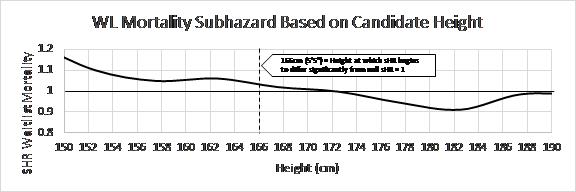Identifying a Clinically Relevant Cut-Off for Height That is Associated with a Higher Risk of Waitlist Mortality in Liver Transplant Candidates
University of California - San Francisco, San Francisco, CA
Meeting: 2019 American Transplant Congress
Abstract number: C283
Keywords: Allocation, Economics, Resource utilization
Session Information
Session Name: Poster Session C: Liver: MELD, Allocation and Donor Issues (DCD/ECD)
Session Type: Poster Session
Date: Monday, June 3, 2019
Session Time: 6:00pm-7:00pm
 Presentation Time: 6:00pm-7:00pm
Presentation Time: 6:00pm-7:00pm
Location: Hall C & D
*Purpose: We have previously demonstrated that candidate height explains a substantial proportion of sex-based disparity in waitlist (WL) mortality among liver transplant (LT) candidates. To facilitate clinical decision-making, we we sought to identify a clinically relevant height cut-off below which WL mortality increased significantly.
*Methods: We examined all U.S. non-status 1 adult (≥18y) LT WL candidates from 1/2010-12/2014 using UNOS registry data. We used an application of the minimum P-value approach with univariate competing risk regressions (deceased donor LT (DDLT) as the competing risk) to detect differences in WL mortality (=death/delisting for sickness) with regards to height. To search for the optimal cutoff, we conducted a recursive application of this approach with successively smaller height intervals. Multivariable competing risk regression associated the identified height cutoff with WL mortality, adjusting for relevant clinical and demographic variables.
*Results: Of 69,883 WL candidates, 36% (24,819) were women and 64% (45,064) were men. Median height for all was 173cm: 163cm in women, 178cm in men. In univariate competing risk regression, each cm increase in height was associated with 1% decreased risk of WL mortality (95%CI 0.99-0.99, p<0.01). The optimal search method of evaluating successively smaller height intervals yielded 166cm as the maximum height cut-off (Fig).
Using height<166cm as the cut-off to define “short”, 72% women and 9% men were “short”. Short candidates were more likely to be Hispanic (23% v. 12%) or Asian (8% vs. 3%), have blood type O (48% v. 46%), NAFLD (13% v. 9%) or Hepatitis B (16% v. 9%), or located in a high MELD region (56% v. 50%). Compared to candidates ≥166cm, “short” candidates had higher rates of death/delisting (28 v. 24%) and lower rates of DDLT (38 v. 44%) [p<0.01 for both]. After adjustment for these characteristics, height <166cm remained associated with 8% increased risk of WL mortality (95%CI 1.03-1.14, p<0.01).
*Conclusions: We have identified a height cut-off of 166cm (5’5”) as a clinically relevant cut-off below which LT WL candidates experience significant risk for WL mortality. The vast majority (81%) of women were “short”; “short” candidates were also more likely to be minorities, have an unfavorable blood type, and be listed in high MELD regions. Short candidate height may be a motivation to explore split livers or living donors as accelerated LT options.
To cite this abstract in AMA style:
Ge J, Lai JC. Identifying a Clinically Relevant Cut-Off for Height That is Associated with a Higher Risk of Waitlist Mortality in Liver Transplant Candidates [abstract]. Am J Transplant. 2019; 19 (suppl 3). https://atcmeetingabstracts.com/abstract/identifying-a-clinically-relevant-cut-off-for-height-that-is-associated-with-a-higher-risk-of-waitlist-mortality-in-liver-transplant-candidates/. Accessed December 23, 2025.« Back to 2019 American Transplant Congress

